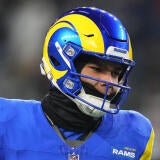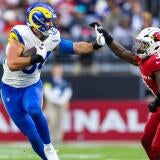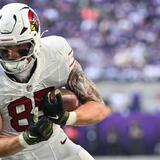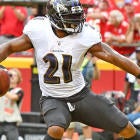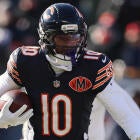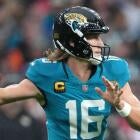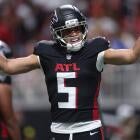Stealing Signals: AFC North 2019 recap, what to expect heading toward 2020
Ben Gretch reviews the 2019 season for each team from the AFC North.
With the 2019 regular season in the books, I'll be going division by division to share my initial offseason takeaways from each team.
This is mostly postseason note-taking as I emphasize what stands out most from the Stealing Signals column in 2019. We have an entire offseason of coaching and personnel changes plus additional research to break down what our 2020 Fantasy expectations will be, but I intend to refer back to these pieces as a barometer of sorts.
Baltimore Ravens
Snap Notes: Heavy rotation, often specific to game plan -- outside Nick Boyle, a primary blocking tight end, no skill position player played more than 80% in any game all year, and in 11 games no one outside Boyle hit 70%
Key Stat: Lamar Jackson -- 6.9 YPC, 9.0% pass TD rate
Baltimore's season was defined by its likely-MVP quarterback Lamar Jackson, who shattered Michael Vick's record of seasonal rushing yards for a QB while also leading the league in touchdown rate as a percentage of pass attempts by more than a full percentage point. With the added value of rushing stats, it was close to a perfect Fantasy quarterback season.
Of course, regression will be a big discussion point. Two numbers stand out -- the passing touchdown rate and his league-high 6.9 yards per carry. The two numbers are related, as his rushing efficiency and the rushing efficiency of the offense helped limit his overall pass attempts, and the effectiveness of the offense overall meant more scoring opportunities, both of which helped him post such a high per-pass touchdown rate.
An interesting data point for his 6.9 yards per carry is the 4.7 mark in his rookie season, during which he rushed 147 times compared to 176 in 2019. Jackson's true talent level is clearly high, but the 4.7 mark on a similar sample of overall rushes suggests maintaining nearly 7 yards per carry could be difficult. Further complicating matters is whether offensive coordinator Greg Roman stays or moves on to a head coaching gig, though those roles are filling up fast. Roman is largely credited with installing the offense that allowed Jackson to flourish, following a pattern of Roman designing efficient offenses around mobile quarterbacks like Colin Kaepernick and Tyrod Taylor throughout his coaching career. But even if Roman goes, and even if we should expect some efficiency regression, Jackson presents a nearly perfect Fantasy quarterback — one who will provide an incredibly high weekly floor with his legs and is involved in a high percentage of his team's touchdowns. He's my QB1 next year even as I expect Patrick Mahomes to rebound.
The Ravens' skill position players can be lumped together somewhat, with three key names standing out. None played significant snap shares at any point in the season, and all benefited from Jackson's impact on the overall efficiency of the offense through elevated yardage and touchdown rates.
On just 228 touches, Mark Ingram had one of the better Fantasy seasons of his career. His five receiving touchdowns on just 26 receptions are fluky, and his 15 overall scores helped boost him to RB11 in PPR. Efficient running quarterbacks have a positive impact on the rushing efficiency of their backs, and Jackson was always a threat to keep the ball and run to the edge in Baltimore's offense. That threat helped Ingram post 5.0 yards per carry, a tenth of a yard off his career high. That's probably more sustainable than it appears on first blush, but repeating his Fantasy finish will still be a challenge due to the lack of receiving, some of which is also related to Jackson's mobility (i.e. some checkdowns are replaced by scrambles).
Marquise Brown had an at-times electric rookie season, but battled injuries. By Week 4, Brown's snap share topped out at 80%, and he had become the clear No. 1 wide receiver. But he got hurt in Week 5 and would return to a more limited role in Week 9. While his seven touchdowns may be hard to match, his rookie season is a clearly positive sign for his long-term outlook.
Mark Andrews stayed in a limited snap role, similar to 2018, but was active in the passing game and remained a high-efficiency option. Andrews finished second to George Kittle in yards per route run among tight ends in 2019, after finishing fourth in that stat in his rookie year. He also carried a high touchdown rate of over 10%, but it seems clear he's an efficient tight end, and if his routes ever tick up he could be a monster.
Among role players, rookie Miles Boykin was solid in limited use and backup running back Gus Edwards had another highly-efficient rushing season, but seems to be only an early-down option. Even with two efficient (and healthy) backs ahead of him, rookie Justice Hill still carved out a limited role, which may be a good sign for his potential. I like him as a 2020 sleeper as any injury issues ahead of him on the depth chart could make him the beneficiary of the Jackson efficiency boost in what will assuredly still be an efficient offense.
Signal: Team -- unique statistical profile with elevated efficiency across many stats for many individual players (though the overall efficiency could regress some)
Noise: Lamar Jackson -- 9.0% pass TD rate
Cincinnati Bengals
Snap Notes: Joe Mixon -- 70%+ in just three games (17+ PPR points in each)
Key Stat: Joe Mixon -- 20+ carries in 5 of final 8 games (hit 20 carries in 0 of first 8 games)
The Bengals had a disappointing first season under Zac Taylor, with Andy Dalton eventually getting benched and fourth-round rookie Ryan Finley looking raw in three starts. Dalton's contract includes no dead money after this year with a potential cap hit of $17.7 million, so he will almost certainly be cut as the team prepares to take a quarterback — likely Joe Burrow — with the No. 1 overall pick.
Joe Mixon is the biggest Fantasy name in the offense, and we know running backs suffer when overall offensive efficiency is poor. A disappointing element to Mixon's Fantasy season was Giovani Bernard often running more routes, maintaining a not-insignificant role as the No. 2. Bernard didn't miss a game, but he left two early -- Weeks 10 and 13, which were two of the three times Mixon's snap share crested 70%.
But even in the other late-season contests, Mixon's usage skyrocketed, as he averaged 24.1 touches and 124.2 yards in the final eight games after the Bengals' Week 9 bye. Prior to the bye, he averaged 15.0 touches and just 53.8 yards. That late-season explosion will make Mixon a tough player to evaluate, as it came as the offensive line finally got healthy and could foretell a breakout 2020, or it could be a red herring if a healthy Bernard continues to eat into his receiving work.
A.J. Green never played, which allowed Tyler Boyd to amass 148 targets as the clear No. 1. His efficiency fell across the board from his breakout 2018, but I'm mostly giving him a pass on that and focusing on the volume he earned. We now have two solid seasons that back up Boyd's excellent collegiate production after a slow start to his career.
Former top-10 pick John Ross spent most of the season on IR, but not before a brief early season breakout. Ross' first two seasons were mired by injury and seemingly being parked in Marvin Lewis' doghouse, but the rare speed he possesses has become an important commodity in modern passing schemes like the one Taylor employs.Ross will be a boom-or-bust option in 2020 suited well for best-ball leagues.
Auden Tate, a seventh-round pick in 2018, got extended run in his second season, and acquitted himself well considering the overall inefficiency of the offense and some injury issues late in the year. Tate played the whole season at just 22 years old, as he was a young rookie in 2018, and has far more long-term upside than 27-year-old Alex Erickson, who is more of a special teams player who also saw increased work in the depleted pass-catching corps.
There was some tight end value in this offense, but not enough to move the needle considering the available targets. Tyler Eifert and C.J. Uzomah split work -- over the course of the season, Eifert ran 356 routes to Uzomah's 255. Eifert is a free agent heading into the offseason.
Signal: Tyler Boyd -- heavy volume in 2019, solid two-season average that includes a much more efficient 2018
Noise: Joe Mixon -- it's hard to parse the good and bad between Giovani Bernard's continued presence and Mixon's late-season surge
Cleveland Browns
Snap Notes: Nick Chubb -- 74% average snap share before Kareem Hunt's return, 64% after
Key Stat: Nick Chubb -- 3.1 receptions per game pre-Hunt, 1.4 after
The hopeful 2019 Browns season never really took off, despite a very talented roster. I'm not someone who will frequently cite a concept like discipline, and yet I think it's at least somewhat significant — the Patriots are a great example of the power of winning in small ways across various elements of your organization.
The 2019 Browns were in many ways the anti-Patriots, a team that outwardly seemed undisciplined and unable to achieve success, from traditional factors like play-calling and individual player performances to bizarre storylines like former No. 1 overall pick Myles Garrett's actions in the Steelers game that led to his suspension for the remainder of the season and reports that Browns players, perhaps led by star offseason acquisition Odell Beckham, were telling opposing coaches to "come get" them during games late in the season.
Much of the optimism last offseason centered on offensive coordinator Todd Monken, who had previously coordinated an aerial attack in Tampa Bay. As the season went on, Monken's commentary painted a picture of dysfunction -- he reportedly went so far as to tell opposing coaches things were "a total mess" -- and reading between the lines it seemed clear he didn't have much influence. With coach Freddie Kitchens and general manager John Dorsey both gone, there's potential for a post-hype breakout for this offense in 2020.
Baker Mayfield regressed in 2019, and it was apparent early he was holding the ball too long, potentially trying to do too much while playing within a system that didn't set him up for easy reads and easy throws. I wrote about that as early as Week 3. The talent is still there for Mayfield, and I expect he can rebound his career and find success in a better situation.
Nick Chubb was tremendous as a runner all season, but his receiving fell off when Kareem Hunt returned. Hunt pretty clearly showed he's still a plus back, and the free agent will likely land in a more prominent role somewhere this offseason. That should open up more receiving work for Chubb, so I'm looking at his solid 3.1 receptions per game pre-Hunt more than his 1.4 per game down the stretch when evaluating Chubb's 2020 receiving potential.
The perennially-underrated Jarvis Landry led the team in receiving, finishing WR12 in PPR following seasons of WR19, WR4, WR13, WR11 and WR30, working back to his rookie year. He'll still likely be drafted outside the top 20 wide receivers next season, despite the fact that he hasn't missed a game and has caught at least 80 passes in each of his six seasons.
We learned late in the year Beckham played through a sports hernia/groin injury, but he played 16 games for the first time in three years and posted a 1,000-yard season. He'll be a bounce back-candidate after finishing fourth in the NFL in air yards but posting career lows in catch rate and touchdown rate.
David Njoku got injured in Week 2, and was later brought along slowly due to a coach's decision, a bizarre turn of events for the former first-round pick with plus athleticism across the board. Still just 23 until next July, he'll be a popular late-round option with boom potential in his fourth season under a new coaching staff.
Signal: Nick Chubb -- great rushing talent, solid receiving role before Kareem Hunt's return; Kareem Hunt -- productive late in the season, potential three-down option depending where he lands
Noise: Odell Beckham -- career-worst efficiency metrics in several categories; Team -- disappointing offensive season relative to talent can likely be chalked up to poor coaching to some degree, something that has the potential to improve
Pittsburgh Steelers
Snap Notes: All six skill players who played at least 40% of the Week 1 snaps missed at least one game later in the season
Key Stat: Team -- 4,428 yards from scrimmage (30th in the NFL; were in the top seven each of the prior five seasons)
The Steelers started off their season with Ben Roethlisberger at quarterback, James Conner as a potential workhorse running back, JuJu Smith-Schuster, Donte Moncrief and Ryan Switzer as their three most active Week 1 receivers and Vance McDonald at tight end. Every player in that list missed multiple games throughout the season, with Roethlisberger most of the season.
I'm tempted to throw out the Steelers entire 2019 season. Backup quarterbacks Mason Rudolph and Duck Hodges fundamentally altered the way the offense operated, and led to a lot of scheming on the fly. There was increased wildcat usage at times, and several games with an uncharacteristically low-volume and conservative (i.e. low aDOT) passing attack.
But there were some things of note. James Washington rebounded from an inefficient rookie season to be an at times electric downfield threat. Third-round rookie Diontae Johnson moved into a solid receiving role by Week 3, and was arguably the team's No. 1 receiving option in December, leading the team with 36 targets in those final five games to Washington's 30.
Both appear to be legitimate passing game pieces going forward, and along with JuJu Smith-Schuster the Steelers have a trio of receivers with complementary styles all entering their age-24 seasons. Johnson is the heir apparent to the Antonio Brown role, while Washington is a deep threat that can open up things for Smith-Schuster and Johnson underneath.
Smith-Schuster was an absolute star over his first two NFL seasons, but he clearly struggled after Roethlisberger got injured early before he suffered injuries of his own that cost him four-plus games. But with Johnson and Washington as legitimate outside weapons, Smith-Schuster could get back to feasting in the slot if Roethlisberger returns for a healthy 2020. I remain very optimistic about Smith-Schuster over a longer timeline, despite his disappointing 2019. He's done too much at too young an age -- and 2019 featured too many outside factors -- to overreact.
James Conner missed six games and played fewer than 20% of the snaps in two others, but still finished with 715 yards from scrimmage and seven scores in just a bit more than half a season. He caught 34 of 38 targets, strong per-game numbers for how much he played, and despite some poor rushing efficiency early in the year, the healthy part of his season has to be considered mostly a success given the state of the offense under Mason Rudolph and Duck Hodges. Assuming he's looking like the lead back again in 2020, there's reason to think he could make good on his 2019 ADP at a 2020 discount.
Jaylen Samuels never really took the lead back role in Conner's absence, but his 47 receptions are notable. Benny Snell rushed over 100 times but caught just three passes all season, so he'll look like the type of handcuff who doesn't have much three-down potential in 2020, and I typically avoid those types of players.
Vance McDonald took several years to make an impact at the NFL level, and will be 30 next June in an offense that won't project for as much available opportunity as last offseason. That he didn't make an impact is tied to both his health and Roethlisberger's, but he'll be a late-round pick for a reason in 2020 despite his impressive athleticism and inherent upside.
Signal: James Washington/Diontae Johnson -- look like legitimate passing game weapons
Noise: JuJu Smith-Schuster -- most of what happened in his 2019 season; Team -- run/pass ratio, total yardage, etc.


